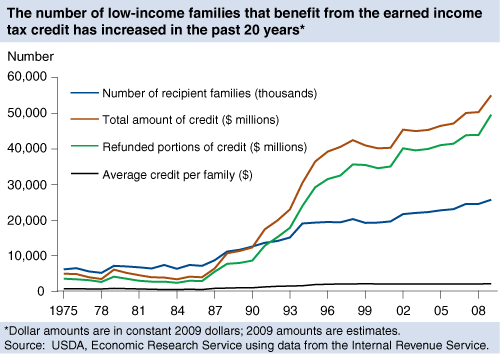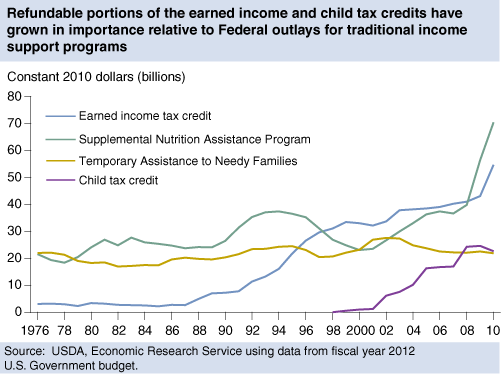Rural America Benefits From Expanded Use of the Federal Tax Code for Income Support
- by Tracey Farrigan and Ron Durst
- 6/16/2011
Highlights
- Over the past two decades, the Federal tax code increasingly has been used as a tool for achieving social and other policy objectives, primarily through the expanded use of tax credits.
- A larger share of rural taxpayers benefit from Federal tax policies aimed at lower income taxpayers because they have historically had lower incomes and higher poverty rates than urban households.
- The earned income and child tax credits have provided a substantial boost in income to low- and middle-income rural taxpayers and have reduced the rural poverty rate.
The Federal tax system has always served purposes beyond the collection of revenue to fund Government programs. In recent years, however, the tax code has been increasingly used to promote or achieve social and other policy objectives, including provisions to encourage home ownership, work, education, and savings as well as to provide income support for families with children.
These special income tax deductions, exclusions, and credits--often referred to as tax expenditures--represent an alternative to direct spending programs to accomplish specific policy objectives. Since 1980, the total cost of all tax expenditures has increased by over 250 percent and currently exceeds $1.1 trillion. These expenditures have significantly reduced the share of taxpayers who owe Federal income tax, and, with the increased use of refundable tax credits--primarily the earned income (EITC) and child tax credits--have resulted in payments to taxpayers who owe no Federal income tax. These tax-based programs have expanded over the past two decades and are an increasing share of total Federal support to low-income households.
Refundable tax credits, especially the EITC, have lifted a significant number of households above the poverty line. While the official measure of poverty does not include the EITC as a form of income, the Census Bureau publishes information on poverty under various alternative definitions. Comparing the poverty rate under the definition of income that includes various support programs and the EITC with the official poverty estimates for 2006 suggests a reduction in the rural poverty rate from 15.1 percent to 11.1 percent. In 2006, the EITC alone was responsible for reducing the rural poverty rate by 1.7 percentage points, which equates to lifting an estimated 800,000 rural residents above the poverty line in 2006. Given expansions in the EITC that have occurred since 2006, as well as the expanded refundability of the child tax credit, the current impact on rural poverty of these tax-based policies is likely to be even greater.
Tax Credits Represent a Large Share of Disposable Income for Many Low-Income Rural Families
The earned income tax credit was enacted in 1975 to reduce the burden of Social Security taxes on low-income workers and to encourage them to seek employment rather than welfare benefits. The amount of the credit depends upon the number of qualifying children in the household and the level of earned and adjusted gross income. The annual amount is equal to a specified percentage of earned income up to a maximum dollar amount. The maximum amount applies for a specified income range and then is gradually phased out for income above that range. Any credit amount above the taxpayer's income tax liability is refunded. For 2010, a childless couple is eligible for a credit of 7.65 percent of earnings up to $5,980, resulting in a maximum credit of $457.
For families with children, both the percentage of earnings and the amount of earnings covered increase with the number of children. For example, a married couple with one child is eligible for a credit of 34 percent of earnings up to $8,970, resulting in a maximum credit of $3,050, while a married couple with three or more qualifying children is eligible for a credit of 45 percent of earnings up to $12,590, resulting in a maximum credit of $5,666. In 2008, the credit provided an estimated $50.7 billion to 24.8 million low-income workers and their families.
Families with children under age 17 potentially are eligible for the child tax credit. The maximum annual amount of the credit is $1,000 per child through 2012 and $500 thereafter. The credit is phased out for single taxpayers with an annual income in excess of $75,000 and for married couples with annual income in excess of $110,000. Through 2012, the credit is refundable up to 15 percent of earned income over $3,000 per year. Families with three or more children also are eligible for a refundable credit to the extent that their Social Security and Medicare taxes exceed their EITC, if this amount results in a larger refundable amount than 15 percent of earned income over $3,000. In 2008, the child tax credit provided a total benefit of $51 billion, with $20.4 billion refunded to taxpayers.
Tax Programs Have Grown in Importance Relative to Traditional Income Support Programs
The three largest Federal income support programs for low-income households are the EITC, the Supplemental Nutrition Assistance Program (SNAP, formerly the Food Stamp Program), and Temporary Assistance to Needy Families (TANF, formerly Aid to Families with Dependent Children). Prior to 1986, the Federal outlay for the EITC was substantially below spending on the main cash welfare programs for low-income families. The expansions that began in 1990 and that have continued over the past two decades have resulted in tax code program expenditures that have exceeded the outlays of the more traditional welfare programs. For example, the actual EITC outlay for 2008 was 3.3 percent greater than SNAP and 86.1 percent larger than TANF. The refundable portion of the child tax credit also provided an amount comparable to the TANF program in 2008.
Rural America Receives a Relatively Larger Share of Benefits
Rural households have historically had lower incomes and higher poverty rates than urban households. In 2008, the average rural taxpayer reported an adjusted gross income of $43,616, compared with $60,841 for the average urban taxpayer. The poverty rate was also significantly higher in rural areas, with 15.1 percent of the rural population living in poverty, compared with 12.9 percent of the urban population. Given the income differential and the prevalence of low-wage jobs, it is not surprising that rural taxpayers benefit disproportionately from programs targeting low-income workers, especially the EITC.
In 2008, 21.6 percent of rural taxpayers received EITC benefits, compared with 16.9 percent of urban taxpayers. The share of rural taxpayers who received the refundable portion of the child tax credit was also slightly higher at 13.9 percent versus 12.6 percent of urban taxpayers. The earned income and child tax credits provided a total benefit of $20.6 billion to rural taxpayers in 2008. Overall, one out of every three rural taxpayers received benefits from the two programs.
The refundable portion of the EITC and the child tax credit provides a significant boost ($13.7 billion in 2008) in income to lower income rural taxpayers. These refundable credits were nearly one-third of adjusted gross income and averaged $1,276 in 2008 for rural taxpayers with adjusted gross income under $10,000 per year. For those with annual income between $10,000 and $20,000, the refundable credits were nearly one-fourth of adjusted gross income and averaged $3,474.
| Adjusted gross income | Refundable earned income and child tax credits ($ millions) |
Adjusted gross income of participants ($ millions) |
Credits as share of adjusted gross income (percent) |
|---|---|---|---|
| Under $10,000 | 2,026 | 6,442 | 31 |
| $10,001 to $20,000 | 6,025 | 25,620 | 24 |
| $20,001 to $25,000 | 2,383 | 16,148 | 15 |
| $25,001 to $50,000 | 2,968 | 45,730 | 6 |
| $50,001 to $100,000 | 273 | 12,472 | 2 |
| Over $100,000 | 2 | 220 | 1 |
| All | 13,680 | 106,633 | 13 |
| Source: USDA, Economic Research Service, based on special tabulations from 2008 Internal Revenue Service tax data. | |||
Overall, EITC and the child tax refundable credits provided a 13-percent increase in income to those receiving one or both of the credits. Also, since tax refunds generally do not constitute income for purposes of determining eligibility or benefits under other Federal or federally funded income support programs, benefits under traditional support programs are not reduced by such credits.
Some of the expanded EITC and child credit benefits were recently extended but will expire at the end of 2012. As interest in tax reform and simplification continues to grow and the expanding Federal budget deficit places increased pressure on both direct spending programs and tax expenditures, the future of these benefits is uncertain. Given the significance of these policies to low and middle-income rural residents, the debate with regard to the extension of these provisions and the future structure of the Federal income tax system are of considerable importance to rural America.
This article is drawn from:
- Durst, R. & Farrigan, T. (2011). Federal Tax Policies and Low-Income Rural Households. U.S. Department of Agriculture, Economic Research Service. EIB-76.
You may also like:
- Farm Household Well-being. (2013). ERS. The well-being of farm operator households is not equivalent to the financial performance of the farm sector or of farm businesses because there are other stakeholders in farming, such as landlords and contractors, and because farm operator households often have nonfarm investments, jobs, and other links to the nonfarm economy. ERS uses several classifications of farm operator households (farm type, gross sales, and commodity specialization) when reporting indicators of economic well-being, which include: Income Wealth Access to health care..
- Federal Tax Issues. (2012). ERS. Federal tax policy plays an important role in the well-being of farm and rural households and the viability of farm operations. In recent years, Federal income taxes on both farm and nonfarm income accounted for nearly two-thirds of the farmer's total Federal tax burden, while Social Security and self-employment taxes represented nearly a third. These taxes can have a significant effect on the financial well-being of farm households, with impacts varying by farm household type. Beyond a farm operation's income, the tax code influences farm management and other decisions, such as capital purchases and dispositions, and farm estate planning. The tax code can also affect eligibility for Federal program payments, because they are linked to measures of adjusted gross income (AGI)..



